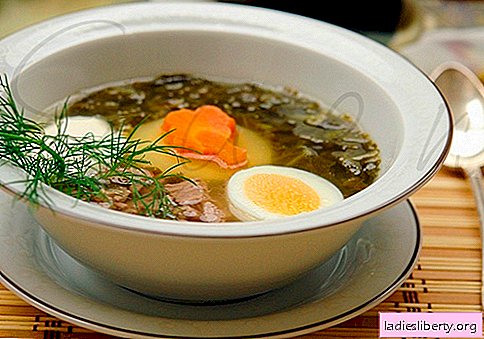
Grapes - garden culture of warm climate.
But some varieties successfully take root not only in mid-latitudes, but also in the north of the country. It is only important to provide seedlings with the necessary conditions for growth - a reliable shelter for the winter, timely pruning and sufficient moisture.
Which grade to choose for planting?
Growing grapes at home, start by choosing a variety. There are about 70 species and 15,000 plant varieties - there is plenty to choose from as a gardener! Choose a variety that will later “settle down” on your plot, focusing on your own gastronomic preferences, climatic features of the region, and the time of plant ripening.
And what exactly are you going to grow grapes on your plot - for juice or wine, to eat enough in season or “to be”?
All plant varieties are divided by specialists into technical (they make wine) and dining rooms (for eating). Technical subspecies of grapes are sweeter, their berries are smaller. Popular technical varieties that are not demanding in the care - Crystal, Platovsky, Marinovsky. Dining varieties are suitable for further sale - they are tasty, many are resistant to low temperatures and pests.
Experienced gardeners prefer the following table varieties: Hope, Delight, Victoria, Codreanca, Cardinal. The table-technical types of plants that can be served or prepared from berries are delicious wine are also derived. Lydia, Isabella, Kuderka.
When choosing a variety, take into account the time of its ripening, since the necessary conditions that need to be created for seedlings will depend on it.
Grapes can be:
• Early maturing (Georgian Early, Golden Early, Muscat, Tairovsky, Dream, Russian Amber, Don Agate, Delight, Dove, Friendship, Cardinal). Ripens in 95-120 days.
• Mid season (Bianca, Neptune, Dessert, Motley). Ripens in 120-135 days
• Late maturity (Isabella, Lydia). Ripens in 135-160 days.
Early grape varieties suitable for growing in the northern latitudes of our country. Middle and late ripening plants are planted by gardeners living in the southern regions. Neither irrigation nor dressing can accelerate the ripening of the grapes, therefore, focus on the average daily temperature indicators in your area.
For growing grapes cuttings is also important characteristic of the growth power of the selected variety. The vigorous varieties (Moldova, Original, Codreanca) are excellent fruits, subject to the necessary conditions for growth, but will require large areas for growing and additional installation of supports. Over the years, the yield of plants increases, but it is becoming increasingly difficult to cover them for the winter. Medium and low growth (Donetsk Pearl, Timur, Novinka, Kiev early) grapes can be planted in rows, saving space. Covering them is easy, but they give a crop that is not particularly high - no more than 10 kg from a bush.
For gardeners living in the north of the country, it is important to take into account the degree of frost resistance of grapes. Plants, according to this criterion, are divided into covering and non-covering. Frost-resistant varieties (Lydia, Isabella, Aligote, Rkatsiteli) can withstand temperatures of -20 C.
Choosing healthy seedlings
Have you already chosen the grape variety suitable for all parameters for growing at home at your summer cottage? It remains to find a reliable seller, from which it will be possible to buy high-quality seedlings.
Seed material purchase in May-April. Seedlings need to be planted in large containers and kept until planting at a positive temperature - on the windowsill or balcony. And by May in the markets begin to sell green, vegetative seedlings, which without prior preparation can be planted in the ground.
Look for reliable farmers who are well versed in the cultivation of grapes for cultivation and have their own farms with several "collections" of plants. To get a harvest faster, buy two-year-old seedlings with a developed root system. It would be good to use the recommendations of friends, then the risk of acquiring bad (and even worse - infected) seedlings is minimized. Quality seedlings - what are they?
• The roots on the cut - white.
• Annual shoots - rich green.
• Eyes should not fall off.
• Drying is not allowed.
Choosing a place for growing grapes and preparing the soil for planting
From the right choice of planting place for growing grapes will depend on the yield and durability of plantations. Plants love the sun, and therefore, give the seedlings a well-lit part of the territory, not obscured by trees or buildings. The best option for growing grapes cuttings - the south-western side of the garden. If it is too windy here, choose a place near a low wall of the house or build a protective fence protecting young plants. Is the garden set on sloping ground? Then plant grapes on a gentle south or southwest slope.
Grapes can grow on almost any soil - loam, limestone, sandstone. But the best land for young saplings is powerful, humus-rich soil with groundwater lying at a depth of 2.5–3 m. Soil with an acidity of 5–7 is considered favorable for growing grapes.
Not every gardener boasts fertile black soil in his plot. But preplant soil preparation is important for obtaining high yields. If the ground is excessively clay, the plants need a good drainage before planting. Peatlands need some sand. Sandstone is better to fertilize with manure or compost. “Diminish” the soil by adding lime - 200 g / 1 sq. M. m
Planting grapes on the site
Plant grapes on the site can be seeds or cuttings. The first method is very labor intensive, and fruiting will come at least in 5 years. Therefore, the best option for a beginner is growing grapes by rooting cuttings.
Planting grapes in temperate climates can be carried out in spring and autumn. Annual lignified shoots are planted from mid-April to mid-May, and vegetative - from late May. Experienced gardeners spend the autumn planting from the beginning of October. Work must be completed before the soil freezes.
Do not rush to the relocation of seedlings to a "permanent place of residence." Many gardeners living in the northern regions leave cuttings rooted in large tanks for a whole year. For the winter, “mobile” seedlings are moved to the basement, and are planted in the ground only next spring. In this case, the risks of freezing of young plants are minimized, and fruiting occurs earlier.
Cuttings a day before planting need to be prepared - soak them in clean water, do not touch the upper roots, but just make a refreshing cut. Without wetting the root, the seedling can be treated with a special solution for diseases and pests. And then proceed to landing:

• At the selected site, prepare a hole of 80 * 80 * 80 cm in size (on sandy soils - up to 105 cm in depth).
• Fix the peg in the center of the pit and cover it with gravel or rubble 8-10 cm (for better drainage). Sprinkle the stones with a layer of soil (10 cm). Water the ground thoroughly. Put manure and humus on top (3 buckets). Now you can add superphosphate (300g), ashes and potassium salt (100g) as top dressing.
• To plant a seedling, you need a hole up to 60 cm deep. Remove the stalk from the container with a lump of “native” land right away and gently move it into the recess.
• Cover the hole with soil, so that the grafting site of the seedling (the area where the shoots diverge) is approximately at the level of the soil. Earth pour.
• Tie a seedling to a peg.
• If before planting the grapes you did not harden the seedling, plantings for 7-10 days should be slightly pritenit on the south side.
Autumn planting of grapes is the same. The only difference is that young shoots in the first winter need a safe shelter. To do this, cover them with a plastic bottle with multiple holes. The land around the plentifully watered (3-4 buckets), and then loosened.

If you plan to grow several varieties of plants, group the seedlings according to their “origin”, since they have different planting intervals. The distance between the holes of the sock-wine grapes is 0.8 m. Table varieties will require a greater distance of at least 1.5 m. Between the rows, in order to make it easier to take care of the plantings later, leave 2-2.5 m.
Rules for growing and caring for grapes
In the southern regions of the country, caring for grapes is not difficult - nature itself takes care of plants. In temperate climates, plants are more finicky - it will be necessary to cover the vine for the winter, and make regular feeding. The basics of growing and caring for grapes are as follows:
• Watering. Grapes love moisture, but will not tolerate flooding the site. That is why during planting we provided a drainage layer. The plant develops a strong root system as it grows - it penetrates up to 5 m deep into the soil. Adults planting, because they can "feed" on groundwater, can endure for a long time without irrigation. But it is better to moisten the grapes once a month for 8-10 liters per bush. Do you live in a region where there is frequent rain? Watering may then not be required. To reduce water consumption, use pipes that are buried between landings.
• Top dressing. Grapes preferably three times per season to feed with organic matter and minerals - before flowering, 2 weeks after flowering, just before the ripening berries. With their third feeding, completely remove the organic matter, replacing it with ash. Dilute fertilizers in water and water the plants with it.
• Mulching and loosening. Immediately after planting seedlings zamulchuyte pristvolny circles (land or peat) - moisture will not evaporate for a long time. Layer mulch - 5-7 cm. Loosen the ground around the weeds. In a drought, loosening may be needed more often - it is important that the earth does not turn into a dry lump.
• Katarovka. Each spring, remove the thin roots that have sprouted to a depth of 20 cm. Bare the trunk again covered with earth. In this way, you will stimulate the development of the main root.
• Support. Many grape varieties grow strongly - very soon a fence will be required near the plantings. Use for this purpose decorative fences, the trellis system. If the grapes are planted along the wall, you can lean a ladder against it - the vine will cling to the improvised support. As required, gardeners themselves tie up the plant to the supports.
• Topping. Prior to flowering (for 5-7 days), pinch the fruitful shoots. This ensures the flow of nutrients directly to the inflorescences, the bush grows less, and the growth of the stepsons is activated.
When growing and caring for grapes, pruning of plants plays an important role. Until the end of the summer vines will actively grow, which will require the gardener to form them in a timely manner. Bushes give the desired shape - standard, cordon, fan. When pruning the grapes, use a sharp pruner to keep wounds on the young shoots. The main pruning is done in the fall, when the leaves have fallen from the plant. When forming a bush, leave a third more shoots than the rules require. And if some of the branches do not survive the winter, you will have enough shoots to produce a bountiful harvest. In the spring, assess the damage caused to the grapes by snow and frost. Cut the broken branches from the bushes.
To grape survived the winter, it must be prepared for the cold season. To do this, with the onset of stable frosts, remove the vines from the supports, warm the plant with peat leaves or spruce leaves. To the roots, pour dry soil with a layer up to 10 cm. Previously, the shelter may provoke the awakening of the eyes after a couple of months - and this is their direct death, since they will not survive the severe frosts.

Methods to combat diseases and pests of grapes
If you do not provide the grapes with proper growing conditions, without timely giving measures for treating the bushes with means of diseases and pests, you can lose a significant part of the crop.
Diseases affecting grapes are divided into chronic and seasonal. The first are transmitted "by inheritance" when buying low-quality seed material, and the second occur when the rules for growing and caring for the bushes are not followed.
Grapes are often affected by the following diseases:
• Anthracnose. Fungal disease affecting shoots, leaves, inflorescences and berries. It is expressed in the appearance of brownish spots with a white or dark border on all parts of the plant. An outbreak of the disease manifests itself in rainy weather. Spores can calmly survive the winter on the grapes. Timely handle planting system and contact fungicides.
• Downy mildew (mildew) - The most common disease among many grape varieties. It is caused by a fungus affecting all the green parts of the plant. The first sign of the appearance of mildew - oily spots rounded on the leaves. And on the underside of the spot a mealy patina is formed. If time does not take action, contribute to tissue necrosis. To protect the grapes, do not allow the over-wetting of the area around the plant, mulch the soil, apply potash-phosphorus dressings, and treat with fungicides. The first treatment - with the height of young shoots up to 20 cm, the second - before flowering, the third - when the berries reach the size of peas.
• Mealy dew (oidium). A grayish-white bloom can be seen on the leaves (from the outside and the inside), many parts of the plants are stunted. Oidium can cause irreparable harm to vineyards because it destroys clusters - berries do not develop, they are completely destroyed by mold. Since this fungus appears in too leafy gardens, use agrotechnical techniques that would contribute to the airing of the bushes - hilling, pinching, tying up the vine.
• Gray rot. Fungal plaque covers blooming eyes and young shoots. Gradually, it can cover all the green parts of the plant - bunches of grapes become useless, turning into a "porridge". Fight against gray rot can only fungicides. If cool wet weather is coming, do not forget to stock up on special preparations.
• Black spot (escoriosis). Fungal disease that affects both the green parts of the grapes and lignified parts of it. You can’t confuse black spot with anything - dark-colored necrosis gradually covers the whole plant, weakening its growth, causes the complete death of some shoots. It is difficult to fight with the fungus escoriosis, because it can penetrate deep into the shoots, eating grapes from the inside. Chemicals have no effect, and therefore, we throw all our forces on preventive measures. Affected parts of the plant are subject to mandatory pruning.

Growing grapes, in addition to diseases, may be complicated by the invasion of pests. The most dangerous "bugs":
• Phylloxera - Aphid yellow-green color, eating only grapes. It is difficult to notice with the naked eye. In gardening, 2 forms of phylloxera are known - leaf and root. The pest behaves differently in the vineyards planted on a particular type of soil. For example, aphid does not develop at all on the sandy ground. Treatment with soil chemicals today is not carried out, and therefore, when detecting the root phylloxera on a bush, it is better to root out the plant.Insecticides are used to combat leaf phylloxera.
• Common Spider Mite. The pest, besides grapes, eats many more plants. He settles on the inside of the leaves and his habitat is always covered with cobwebs. The leaflets affected by spider mites redden or turn yellow. The attacks of spider mites lead to a decrease in the sugar content of berries.
• Grape pruritus. The pest develops on the leaves, in rare cases - on the inflorescences. Where the itch has settled, bumps appear on the outside of the leaf. Damage leads to a violation of photosynthesis of grapes - the foliage falls.
• Little wisps. Caterpillars (there are several species) pests affect the leaves, inflorescences, berries. Damaged parts of the grapes should be cleaned of bark and pupated caterpillars. The best method of dealing with leaflets is the use of chemicals.
Manifestations of diseases and pests can be avoided if you follow the rules of agricultural technology of grapes.











